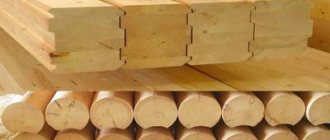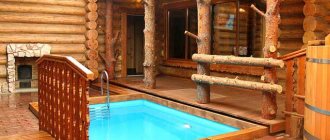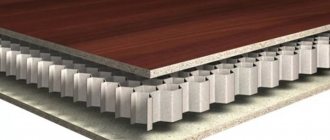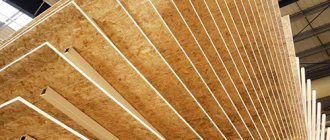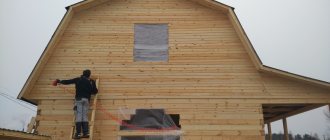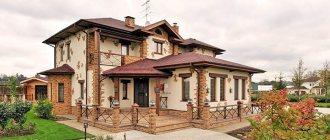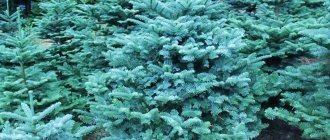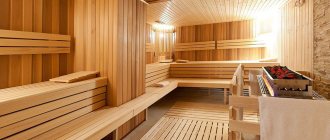MDF and chipboard are boards with different structures, which are used partly in construction, and mainly in assembling furniture. For the uninitiated person, these materials are absolutely the same, but in fact this is not the case. In this article, we will understand how chipboard differs from MDF, consider the characteristics of each of them separately and make a comparative analysis to eliminate all related issues in the form of a table.
Differences between MDF and chipboard materials Source drevesina.net
What is chipboard and MDF board?
The production of MDF and chipboard occurs using similar technologies and at first glance, it is quite difficult to find external differences between them. But if we take a closer look at their production in general and the raw materials used for it in particular, the differences that affect the scope of application of the materials will be quite significant.
Chipboard - production and use
The raw material for producing chipboard sheets (particle board) is sawdust. The production process consists of mixing raw materials with a binder, which uses various formaldehyde resins, and pressing the resulting mass.
Chipboards.
When the base is ready, an outer decorative layer can be glued onto it, resulting in such subtypes of material as laminated chipboard (laminated chipboard) and KDSP (laminated chipboard). In the second case, paper “set” on glue is used as a covering, which in many respects is inferior to laminate, but is more attractive in price.
Chipboard boards.
The areas of application of chipboard are the production of cabinet furniture, cargo packaging and various construction works.
MDF - production and use
Technologically, the production of MDF boards (fibreboard) is similar to the production of paper - at least the preparation of raw materials is done in the same way up to a certain point.
To create MDF, not whole shavings and sawdust are used, but crushed to the state of individual wood fibers. This means that any waste from the wood processing industry can be used as a raw material.
At the first stage of preparing the raw material, it is ground to the size of crumbs, after which it is cleaned with hot steam, which is supplied under pressure. After this, the cleaned and moistened mass is fed to a defibrator, which finally grinds its particles to a minimum size.
The last stages of production are drying the raw materials, mixing the entire mass with special resins and hot pressing into finished slabs. The result is a material that in many respects is not inferior to natural solid wood. It found its main application in the furniture industry, since in other industries it is more profitable to use cheaper analogues.
MDF boards of various thicknesses.
You can learn more about all the characteristics of materials only by comparing them with each other. This will clearly show how chipboard differs from MDF and which is better to choose for certain tasks.
General requirements for care and operation
When choosing a place for furniture made of MDF or laminated chipboard in the kitchen, you must take into account that both materials are resistant to temperatures above 75 ℃. When exposed to high heat, the coating begins to peel off. For this reason, heating devices should not be placed in close proximity to furniture.
If a furniture set is constantly illuminated by the bright sun, then it may simply fade and lose its attractiveness. Chipboard lamination is especially susceptible to fading.
Severe wetting of the slabs is undesirable, although they can withstand short-term exposure to water well, which is why they are used for sinks and other kitchen furniture. Much depends on the quality of the material. There are often cases when laminated chipboard sheets begin to become saturated with water, swell, and crumble. Such furniture takes on a terrible appearance, is destroyed, and becomes completely unusable.
General rules of care are:
- wipe the dust with a dry cloth or a special compound for plastic;
- promptly remove moisture from the surface with an absorbent sponge;
- do not overload hooks and shelves so that fasteners do not break off;
- Do not use waxes and mastics intended for polished wood.
The last point is worth focusing on. Polishing agents intended for wood are not suitable for MDF and laminated chipboard. The laminated film may change color under their influence and even peel off. You should also not use acids, alkalis, or abrasives.
Both types of slabs are resistant to pests and mold. In a dry room, they can stand for decades without any additional treatment without collapsing. They are used to make beds, tables, cabinets, chests of drawers, bookcases, shelves, and all kinds of kitchen cabinets.
Strength and Density
This parameter is directly affected by the raw materials used in production. Since chipboard is made from solid chips, which can be arranged in any order, its average density will be different, and in a fairly large range - from 350 to 650 kg/m³. At the same time, there are several varieties of chipboards, which differ from each other in compaction density and the ratio of raw materials to the amount of binders.
During the production of MDF, the raw materials are crushed to an almost homogeneous state, so there are no such large differences in density - the average is in the range of 720-870 kg/m³.
As a result, MDF is significantly stronger in strength than chipboards, and in some cases, even certain types of solid natural wood.
Determining what is better
Based on the above comparative characteristics, we can conclude which composition will be better. However, each of them is good for specific purposes. We suggest studying these nuances.
MDF panels with wood imitation Source jaf-shop.ru
For example, if first of all you need to select a budget material, then undoubtedly it will be chipboard. But such sheets only serve well in conditions without moisture.
MDF material will cost several times more, but will last longer, since it is not subject to the negative influence of moisture and does not emit hazardous substances during operation. Sheets made from this raw material are quite acceptable for everyday use. Even when making decorative elements for furniture, MDF is the best option, because it can easily withstand curved cutting and shape changes, unlike chipboard.
Thin sheet furniture panels made of MDF Source novocherkassk.tiu.ru
Nevertheless, particle board can also be used for the manufacture of furniture structures. Only sheets need to be selected in the most expensive version. These contain a minimum of toxic substances and are coated with special impregnations that improve performance characteristics: strength, moisture resistance, fire resistance.
On a note! Both of these materials are used in some industries to create an effective combination. For example, in the production of kitchen units, the frames are made of chipboard, and the shaped elements or facades are made of MDF.
Which material is more environmentally friendly: chipboard or MDF?
According to this indicator, all the cones go to the share of chipboard, since formaldehyde resin is used as a binder in its production. In addition to the fact that these are simply compounds of substances harmful to human health, they also actively evaporate from the surface of the stove. The intensity of evaporation is affected by temperature.
According to the environmental safety class in Europe, chipboard sheets are made into two types - E1 and E2, but if this material is made according to domestic standards, then all its parameters are regulated by a single GOST. This does not allow for an accurate classification, the need for which is long overdue, since E2 is prohibited for use in the manufacture of children's furniture, and in some countries it is completely discontinued.
The MDF production technology involves the use of the dry pressing method, which is produced under high pressure and temperature. The binder is also used here, but it uses urea resins that are less harmful to humans. To be fair, it should be noted that they also contain formaldehyde, but a small amount, and in the manufacture of MDF, the resins are additionally modified with melanin, which significantly reduces the already small amount of evaporation.
The emission of harmful substances contained in MDF is significantly lower than in chipboard, therefore, in terms of environmental friendliness, fiberboards are superior to chipboards.
Environmental properties
MDF is considered the most harmless and non-toxic material. This is due to the use of natural binders based on paraffin or lignin in its production. Their combination with wood dust does not cause allergic reactions or other negative consequences in people.
The content of phenol-formaldehyde resins in chipboard makes it more toxic by default. Harmful exposure usually occurs through inhalation of dust from cutting boards or the release of fumes from heating and combustion.
There is a gradation of chipboard according to toxicity classes, while the least dangerous class is not limited in its area of application. The peculiarities of the domestic trade sector do not always make it possible to reliably determine the class of the purchased material. Try to avoid using chipboard to decorate your child's room.
Which board is more resistant to moisture: chipboard or MDF?
In its pure form, the chipboard slab does not tolerate moisture very well - when wet, its base actively begins to absorb water and can increase its volume by about 30%. Laminate chipboard has slightly better moisture resistance - laminate itself is not afraid of water and can resist getting wet for quite a long time, which is why it is often used to create budget-class countertops.
It has proven itself to be excellent, but if the outer coating is damaged, all the shortcomings are fully revealed - if water seeps into the slab, it will be actively absorbed.
Chipboard that has been wet.
Since MDF itself is a denser material, even without an external coating it resists getting wet well and, even if it gets into water, it can hold its shape for several hours, which is superior even to some types of natural wood.
Tendency to mechanical damage
The strength characteristics of both materials are quite high. If we compare in relative terms, the fine-mesh structure of MDF tends to withstand higher loads (bending and torsion). The downside of the coin is the lower hardness of the material, which leads to relatively easy crumbling.
Chipboard sheets have less strength, but are not as sensitive to point loads as MDF. Higher hardness allows the material to be used in a less gentle mode, in terms of mechanical stress.
What is more difficult to process: chipboard or MDF?
As in the case of density, the raw materials used in production are responsible for this parameter. Since chipboard consists of solid chips, it lends itself very poorly to fine processing - all cutting lines that are not straight can lead to chipping.
Since finely divided raw materials are used to create MDF, this is reflected in the structure of the material, which is more uniform and dense. This material easily tolerates any type of processing - sawing, figure cutting or milling.
Milled MDF.
Due to its ease of processing, MDF is widely used in the manufacture of carved facades, trims and moldings used in furniture production. According to this indicator, MDF has the upper hand.
Labor costs in processing
Despite its greater strength and weight, MDF is much easier to machine and shape into the desired shape. This is especially important when cutting blades to specific dimensions for floors or furniture. Chipboard has greater hardness, which is explained by the rigidity of the adhesive base and the larger size of the wood chips.
To obtain chipboard of the required size and shape, it is necessary to use automatic equipment and be sure to protect the respiratory system with a respirator. When processing MDF, it is enough to use a hacksaw for wood, carrying out the most delicate work with a hacksaw for metal or a jigsaw.
Working with MDF is more tedious due to its higher density (by 0.1-0.2 kg/m3) and the weight of the canvas. In small volumes of work, the difference is not so noticeable and is felt only when the surface being processed is large.
Possibilities for decorating chipboard and MDF
In the case of particle boards and fibreboards, decoration means finishing these materials with additional layers of laminate or veneer. If in the second case there are usually no problems, then when decorating with laminate or paper with chipboard there may be difficulties. They are caused by the initially rough surface of the slab - if a thin film is glued to it, then all the tubercles and veins will be visible on it. As a result, all chipboard slabs are sanded and only after that can film or paper with a pattern be applied to them.
MDF sheets are initially devoid of such disadvantages due to their density - immediately after production they are suitable for applying any decorative coating.
How to choose a safe material
To purchase safe finishing products or furniture, you must consider the following recommendations:
- Release occurs only through uncovered or untreated surface areas. Most often these are the ends of panels and parts of interior items made from chipboard. In the “economy” segment chests of drawers, the invisible edges of the drawers remain open. The area of these elements is very small to indicate high toxicity. But if in doubt, it is better to give preference to more expensive products or additionally lay the edge on open areas.
The higher the level of lamination of furniture boards, the safer they are considered - It would be a good idea to check for security certificates. You should pay attention not to functional indicators, but to environmental standards.
- The environmental friendliness of MDF is much higher than even chipboard (laminated material). In addition, medium-density fiberboard for cladding or furniture work most often has a film on the surface, which completely eliminates evaporation.
In general, any low-quality cladding materials can be dangerous.
Fastener retention
Chipboard has long gained the reputation of a “disposable” material - furniture assembled from it is very difficult to disassemble without loss, transport to another place and reassemble. This is due to the fastenings, which, even if the screws are screwed in and out perfectly evenly during reassembly, at best will hold much weaker. The worst is also the more likely outcome - the attachment point will simply crumble and you will have to additionally treat it with glue or use screws of larger diameter.
As a result, if you have a choice, then you should take furniture made of chipboard, in which not screws are used as fasteners, but bolted connections with wide washers. If they break, then you won’t have to worry about the possibility of restoring the fasteners.
MDF, due to its density, easily tolerates repeated assembly and disassembly - in this, again, it is not very different from natural wood.
Choice for furniture
Both materials are suitable for its production, but the location and environment in which they will be used must be taken into account. A significant advantage of MDF when choosing between it and chipboard is its environmental friendliness. And although, in the event of a possible fire, its fibrous component ignites faster, thanks to its natural components it does not emit harmful toxic substances. From an economic point of view, chipboard is much cheaper than its counterpart, therefore the furniture costs much less. It is important to know whether MDF panels have the same dimensions or can be selected according to size.
But it should be taken into account that cracks may appear in the places where parts are attached to the chipboard, and if you pull the handles carelessly from their places, then along with them you can tear out a piece of material and get a hole in its place. Therefore, such furniture is short-lived, despite the hardness of the material. Crushing its parts can create additional household problems, especially if crumbs from the attachment points fall off in cabinets where food products are stored.
Information about moisture-resistant MDF wall panels can be found here.
And MDF is not only soft and tough, but also flexible, so there are no problems with fasteners and handles. The material is flexible enough not to break under heavy loads, even torsion. But it has a high cost compared to chipboard.
The video explains which is better than MDF or chipboard for furniture:
The best option when assembling cabinet furniture, chipboard or MDF, would be to combine these materials, then the overall appearance will be beautiful, and the final cost will be much cheaper. If you plan to order or assemble the cabinet yourself, then you should consider the option of making all the moving parts in the form of doors and shelves from MDF, and the structural frame from chipboard. This combination will extend the life of the product, and it will become repairable.
You can read about MDF wall panels for interior decoration, as well as view all the photographs about this material here from the article.
What is cheaper: chipboard or MDF?
According to this criterion, chipboard will give odds to any material. Of course, you can take into account the types and quality of the external coating and its finishing, impregnation with water and fire-resistant compounds, but in general the difference in cost between MDF and chipboard will be about 50%.
If you compare slabs coated with good plastic, enamel or natural veneer, the difference will be even greater, but here you have to choose between the desire to save here and now when purchasing or in the future - on operation.
3 more things to consider when updating your interior
In any case, it is advisable not to update all the furniture at once, but to do it slowly, in parts. This is quite reasonable: it will hit your pocket less, and you won’t once again test your health “to the limit.”
If you nevertheless decide to replace all the furniture in a room or apartment at once, then it makes sense to ventilate this room more often at first and spend less time in it.
But if you have old, good-quality wooden furniture, and it is not damaged by fungus and other pests, then maybe the best option is not to buy anything at all, but just leave the old one? Moreover, it can be restored. One way or another, everyone chooses for themselves what is more important to them - updating the interior at any cost or maintaining health.
By the way, since you are concerned about the topic of toxic furniture, you should pay attention to other harmful materials in your room. There may be no less danger to health, if not more.
Negative health effects of cheap furniture
Low-quality furniture containing large amounts of formaldehyde or phenol can cause various health problems. Here are just the main negative impacts:
- Airways. There is difficulty breathing and swelling of the throat. It becomes difficult for a person, especially someone suffering from asthma or allergies, to breathe. When you are in a room with a lot of cheap furniture, you experience a constant cough, runny nose, and suffocation.
- Mucous. Here the negative effects range from relatively mild inflammation and irritation to irreversible deterioration of vision. For example, children may develop myopia.
- Nervous system. Formaldehyde and phenol are the causes of insomnia, chronic fatigue, loss of performance, and depressed mood.
- Reproductive functions. Low-quality cheap furniture can cause infertility.
- Oncology. It has been proven that increased concentrations of formaldehyde provoke the growth of cancer cells and can cause leukemia.
These are the serious health problems caused by cheap, low-quality furniture made from dubious raw materials. Therefore, when you decide to save a little, think about how much money will ultimately be spent on treatment.



